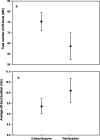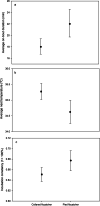Differences in incubation behaviour and niche separation of two competing flycatcher species
- PMID: 32801426
- PMCID: PMC7410113
- DOI: 10.1007/s00265-020-02883-4
Differences in incubation behaviour and niche separation of two competing flycatcher species
Abstract
Abstract: Food availability sets the stage for incubation behaviour of a female bird and thereby indirectly determines the nest temperature, which in turn affects development and metabolism of avian embryos. Changes in development and metabolism in turn are known to influence offspring's ability to adjust to environmental changes later in life. However, few studies have investigated the role of interspecific differences in incubation behaviour in relation to niche separation between competing sibling species. We studied the effects of habitat quality (in terms of caterpillar availability) on incubation behaviour of two ecologically similar and closely related species, collared and pied flycatchers (Ficedula albicollis and F. hypoleuca), in their hybrid zone on the island of Öland, Sweden. Even though both species prefer caterpillar-rich deciduous forests as nesting sites, collared flycatchers, whose nestlings have higher energetic demands, are able to nest only in deciduous forests, whereas pied flycatchers have more flexible habitat requirements. Overall, higher food availability was associated with increased nest attendance, higher incubation temperature and a lower number of foraging trips across species. In addition, collared flycatchers had more frequent and shorter foraging trips across habitat types, allocated more heat to eggs and therefore maintained higher nest temperatures compared to pied flycatchers. We argue that the higher heat allocation or the need to maintain a higher nest temperature for embryo development may constrain collared flycatchers to focus on relatively more profitable prey. Our results highlight the importance of considering incubation behaviour in the context of understanding species differences in niche use.
Significance statement: Niche separation plays an important role in mitigating effects of competition between closely related species. Whether species differences in incubation behaviour relate to differences in niche use remains unknown. We compared incubation behaviour of two sympatric flycatcher species that differ in sensitivity to food availability. The competitively more dominant and larger species, the collared flycatcher, whose nestlings are more sensitive to food shortages, made more frequent foraging trips but allocated more heat to eggs, leading to higher nest temperature despite lower nest attendance, compared to pied flycatchers. These interspecific differences may be a result of differences in embryo sensitivity or female physiology and contribute to the niche separation between the species, which in turn can facilitate coexistence.
Keywords: Flycatcher; Food availability; Incubation behaviour; Interspecific competition; Niche separation.
© The Author(s) 2020.
Conflict of interest statement
Conflict of interestThe authors declare that they have no conflict of interest.
Figures


Similar articles
-
Difference in plasticity of resting metabolic rate - the proximate explanation to different niche breadth in sympatric Ficedula flycatchers.Ecol Evol. 2018 Apr 14;8(9):4575-4586. doi: 10.1002/ece3.3987. eCollection 2018 May. Ecol Evol. 2018. PMID: 29760898 Free PMC article.
-
Life-history divergence facilitates regional coexistence of competing Ficedula flycatchers.Ecology. 2009 Jul;90(7):1948-57. doi: 10.1890/08-0494.1. Ecology. 2009. PMID: 19694142
-
Malaria infections reinforce competitive asymmetry between two Ficedula flycatchers in a recent contact zone.Mol Ecol. 2013 Sep;22(17):4591-601. doi: 10.1111/mec.12409. Mol Ecol. 2013. PMID: 23980765
-
Adaptive coloration in pied flycatchers (Ficedula hypoleuca)-The devil is in the detail.Ecol Evol. 2021 Jan 24;11(4):1501-1525. doi: 10.1002/ece3.7048. eCollection 2021 Feb. Ecol Evol. 2021. PMID: 33613985 Free PMC article. Review.
-
Ecology and genetics of speciation in Ficedula flycatchers.Mol Ecol. 2010 Mar;19(6):1091-106. doi: 10.1111/j.1365-294X.2010.04568.x. Epub 2010 Feb 15. Mol Ecol. 2010. PMID: 20163542 Review.
References
-
- Adamíc P, Bureš S. Experimental evidence for species-specific habitat preference in two flycatcher species in their hybrid zone. Naturwissenschaften. 2007;94:859–836. - PubMed
-
- Ardia DR, Clotfelter ED. Individual quality and age affect responses to an energetic constraint in a cavity-nesting bird. Behav Ecol. 2007;18:259–266.
-
- Arnold KE, Ramsey L, Henderson L, Larcombe SD. Seasonal variation in diet quality: antioxidants, invertebrates and blue tit Cyanistes caeruleus. Biol J Linn Soc. 2010;99:708–717.
-
- Barnett CA, Briskie JV. Silvereyes Zosterops lateralis increase incubation attentiveness in response to increased food availability. Ibis. 2010;152:169–172.
LinkOut - more resources
Full Text Sources
